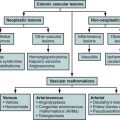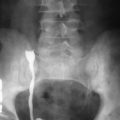Surgical procedures performed on the bowel are innumerable, and their detailed discussion is beyond the scope of this chapter. To understand the related imaging, it is important to be familiar with the postoperative anatomy. Our purpose in this chapter is to present tools to approach the postoperative bowel by discussing some commonly performed surgical procedures, their appearance on imaging, and common complications.
Procedures
Esophageal Resection
All surgical techniques used for esophageal resection have a common characteristic—a segment of the esophagus is resected and reconstructed with anastomosis. The most frequently performed are the transthoracic esophagectomy (either right-sided or left-sided approach), transhiatal esophagectomy, and Ivor-Lewis technique.
Indications, Contraindications, Purpose, and Underlying Mechanisms
Esophageal resection is the treatment of choice for several benign and neoplastic conditions. Benign causes include esophageal perforation, refractory peptic stricture, and large leiomyomas (>5 cm). The most common neoplastic causes include adenocarcinoma and squamous cell carcinoma of the esophagus.
Once the affected part of the esophagus is localized, the surgeon will determine the technique. For example, right-sided transthoracic esophagectomy ( Figure 34-1 ) is preferred in cases involving the upper two thirds of the esophagus because the aorta does not limit access to the esophagus, whereas the left-sided approach is used in cases involving the distal esophagus. The Ivor-Lewis technique is an excellent procedure for patients with midesophageal carcinomas, Barrett’s esophagus, and esophageal destruction (e.g., perforation, caustic injury, persistent esophageal ulcer). This procedure combines a laparotomy with right thoracotomy and intrathoracic anastomosis.
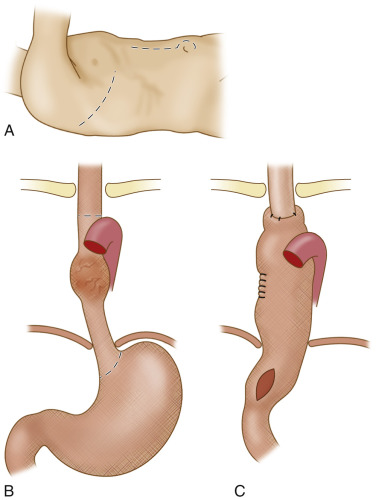
Transhiatal esophagectomy was developed because of multiple complications involved with the thoracotomy approach. This technique involves mobilization of the esophagus through the esophageal hiatus; then the entire thoracic esophagus is transected, and the esophagus is reconstructed with the stomach by an anastomosis with the remaining cervical esophagus ( Figure 34-2 ).
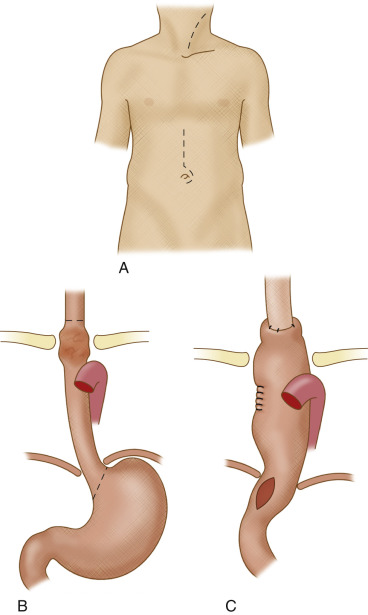
Expected Appearance on Relevant Modalities
The operative report should be reviewed before fluoroscopic evaluation and the anastomotic location is known. In the preoperative or postoperative setting the imaging modality of choice is esophagography. Preoperatively it allows for evaluation of the lesion in question, the location in the esophagus (upper, middle, or lower third), and the preoperative functionality of the esophagus. Postoperatively, it allows evaluation of patency of the anastomosis, functionality of the reconstructed esophagus, and possible recurrent disease. In cases of potential perforation, water-soluble contrast should be used initially to exclude leak and prevent complications such as a chemical mediastinitis.
Considering most complications occur at the anastomosis, this area should be thoroughly evaluated. In cases of transhiatal esophagectomy and gastric pull-through, images on barium esophagography will demonstrate a narrowing within the cervical esophagus that represents the anastomosis and a reconstructed esophagus demonstrating gastric mucosal folds ( Figure 34-3 ). If Ivor-Lewis esophagectomy or a left/right thoracotomy and esophagectomy technique were performed, the esophagogram will show the anastomosis within the chest ( Figures 34-4 and 34-5 ).
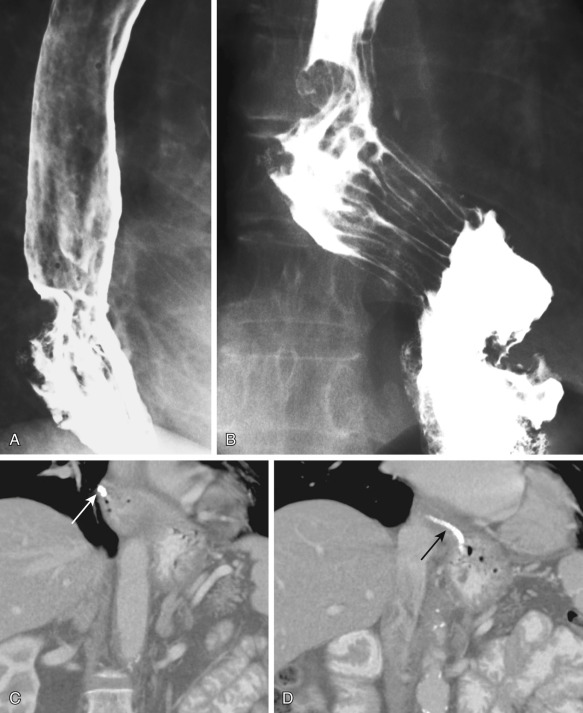
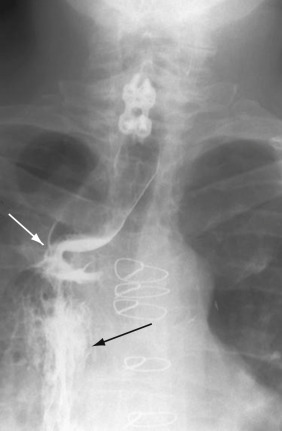
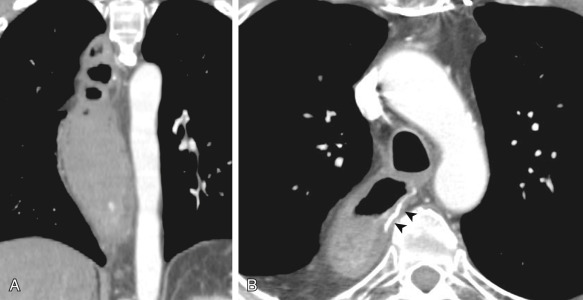
Potential Complications and Radiologic Appearance
Possible postesophagectomy complications include pulmonary (atelectasis, pleural effusions), anastomotic stricture, the most feared complications of anastomosis failure and leak ( Figure 34-6 ), and recurrent disease in patients with esophageal cancer. At our institution, patients are evaluated in the first 24 hours with water-soluble contrast to exclude anastomotic leak. If extraluminal contrast is seen, additional images (e.g., right posterior oblique, anteroposterior, left posterior oblique, magnification) should be obtained for documentation and potential surgical planning. If an anastomotic leak is excluded, the examination can be continued with barium for improved detail.
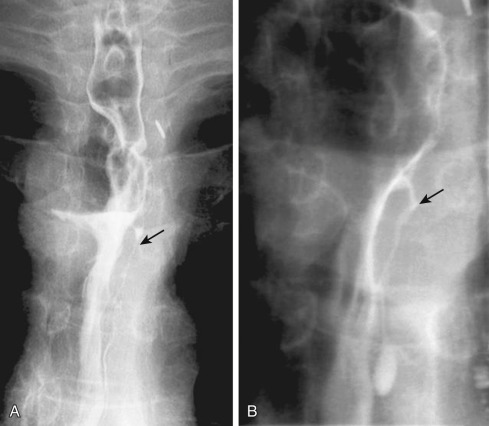
Antireflux Surgery
Surgical intervention is an option in gastroesophageal reflux refractory to medical treatment or in suspected esophageal injury.
Indications, Contraindications, Purpose, and Underlying Mechanisms
Antireflux surgery aims to construct a valve mechanism to reestablish gastroesophageal junction competence. The three most popular are the Nissen fundoplication, the Belsey Mark IV repair, and the Hill posterior gastropexy ( Figure 34-7 ). These procedures can be performed through laparotomy (Nissen, Hill), thoracotomy (Belsey), or laparoscopy (Nissen, Hill).
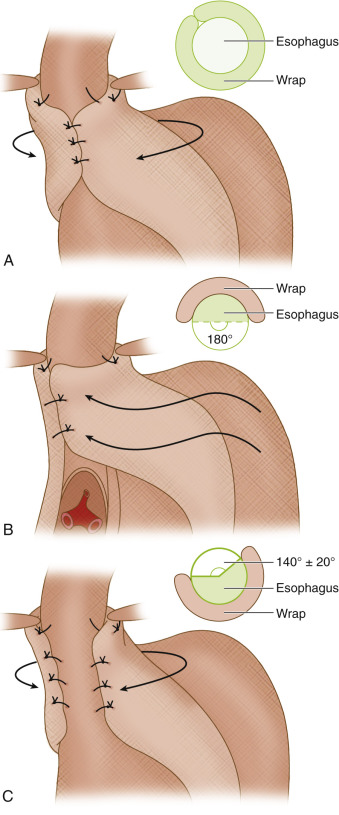
The surgical technique of choice depends on the patient’s preoperative esophageal length and motility ( Table 34-1 ).
| Esophageal Length and Preoperative Motility | Recommended Antireflux Surgery |
|---|---|
| Normal length and motility | Nissen fundoplication |
| Normal length but abnormal motility | Hill or Belsey operation |
| Normal length and motility but prior stomach surgery | Hill operation |
Expected Appearance on Relevant Modalities
Postoperative esophagography remains the optimal study for evaluation. In the preoperative setting it provides information regarding the following:
- •
Esophageal motility
- •
Presence of sliding or paraesophageal hernia (>5 cm)
- •
Significant esophageal stricture or Barrett’s esophagus (segment >3 cm)
The typical appearance of a fundoplication on esophagography is a smooth circumferential narrowing of the distal esophagus that extends for 2 to 3 cm and is associated with a filling defect within the stomach fundus representing the portion used for the wraparound ( Figure 34-8 ).

Potential Complications and Radiologic Appearance
In the postoperative setting, patients presenting with symptoms of dysphagia, epigastric pain, or recurrent reflux warrant evaluation of the fundoplication. These symptoms may be secondary to (1) a tight fundoplication or a long fundoplication that prevents adequate passage of a food bolus, (2) partially or completely herniated fundoplication ( Figure 34-9 ) and acquired paraesophageal hernia, or (3) partially or completely disrupted fundoplication.
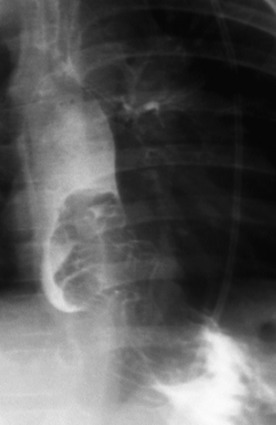
Gastric Bypass
Bariatric surgery is more commonly used in obese patients to improve long-term outcome. The resulting weight loss can improve the quality of life and decrease the use of medications for cardiovascular disease or diabetes.
Indications, Contraindications, Purpose, and Underlying Mechanisms
Bariatric surgery is indicated in patients with a body mass index (BMI) of more than 40 kg/m 2 or a BMI of 35 kg/m 2 associated with comorbidities, such as sleep apnea, diabetes, and obesity-related cardiomyopathy.
Bariatric procedures are divided into two main categories: restrictive and malabsorptive techniques ( Box 34-1 ). Restrictive procedures reduce caloric intake by limiting gastric capacity. Malabsorptive procedures reduce the absorption of calories by reduction of the length of the small intestine. The Roux-en-Y gastric bypass is a combination of both. The gastric pouch serves as the restrictive component, and the gastrojejunal anastomosis represents the malabsorptive component ( Figure 34-10 ). The laparoscopic Roux-en-Y gastric bypass has become the preferred method owing to decreased hospital stays and faster recovery.
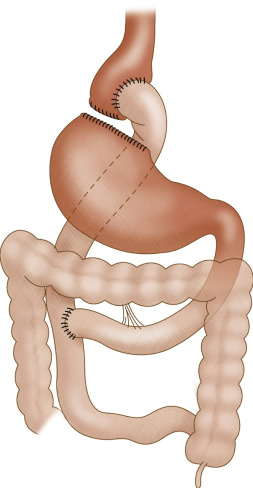
To perform these surgeries, the anatomy of the upper gastrointestinal system has to be intact. Underlying malignancy or an inflammatory process affecting this system needs to be excluded before surgery.
Expected Appearance on Relevant Modalities
Imaging can be challenging because of patients’ body habitus and must be optimized. The two main imaging modalities used are esophagography and CT. The esophagography allows evaluation of the anatomy, patency of the anastomosis in cases of Roux-en-Y gastric bypass, and functionality of the gastric bypass ( Figure 34-11 ). CT allows for evaluation of postsurgical complications such as abdominal free fluid from anastomotic leak and abscess ( Figure 34-12 ) or secondary complications related to the altered anatomy such as afferent loop syndrome. At the gastrojejunal anastomosis after Roux-en-Y gastric bypass, narrowing within the first 24 hours after surgery can be secondary to postoperative edema.
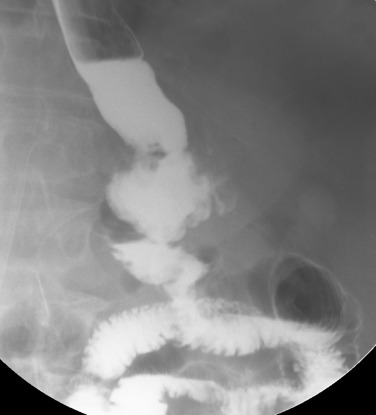
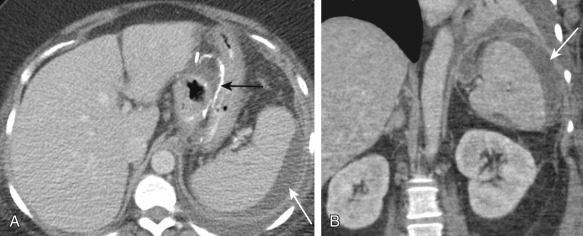

Stay updated, free articles. Join our Telegram channel

Full access? Get Clinical Tree





